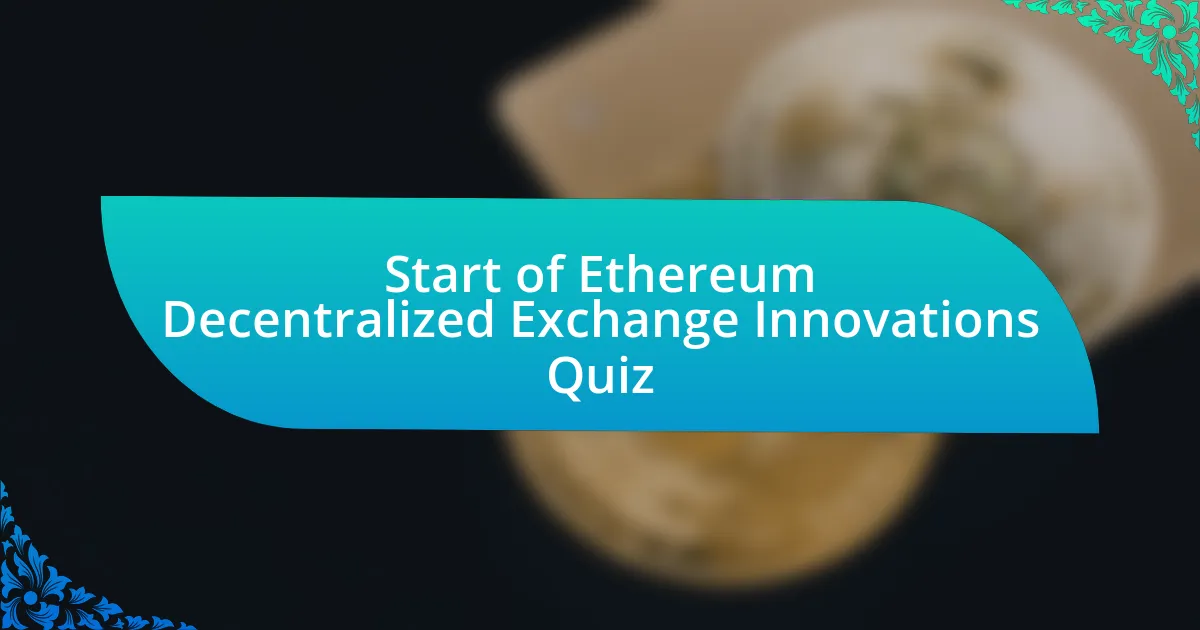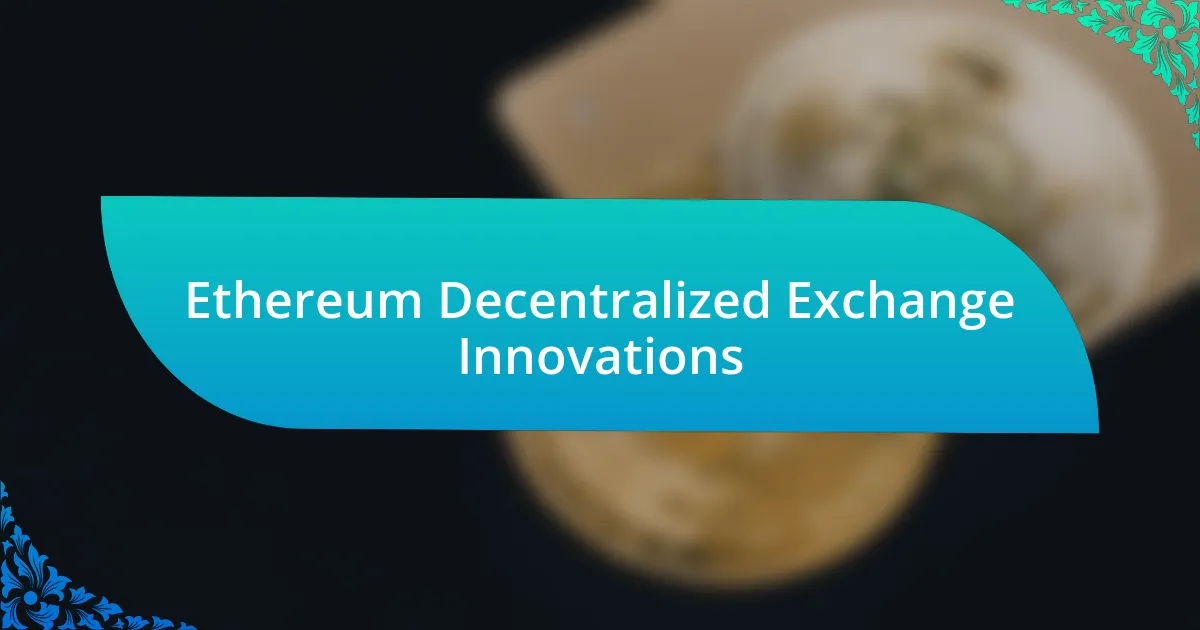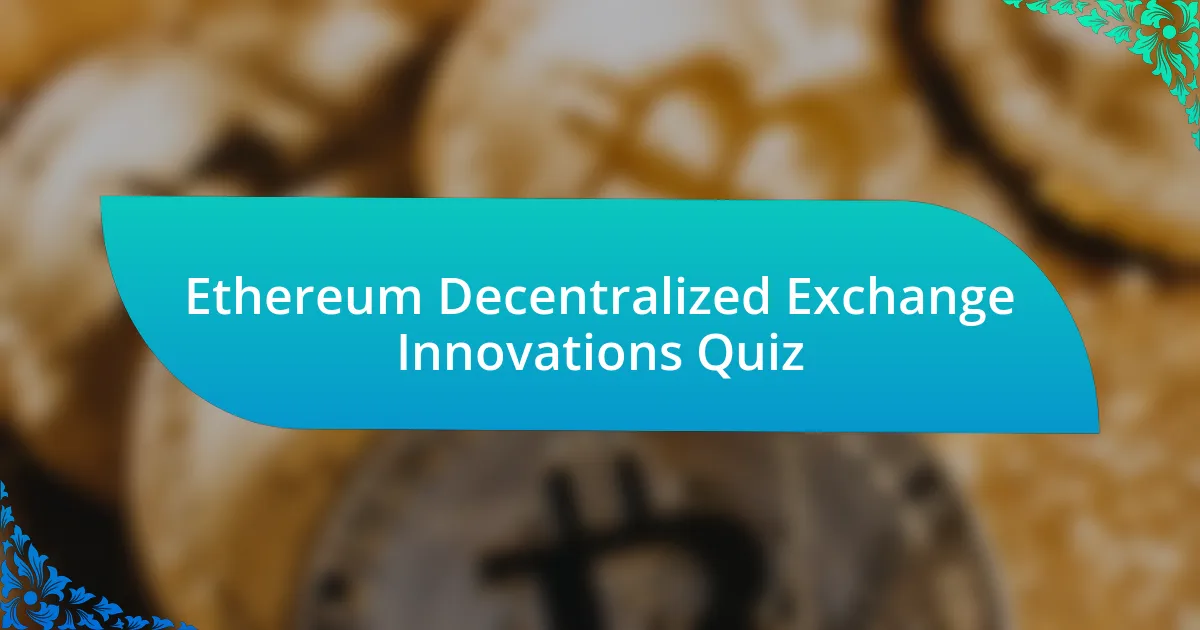
Start of Ethereum Decentralized Exchange Innovations Quiz
1. What is the primary technology used by decentralized exchanges (DEXs) to enable direct user trading?
- Traditional banking systems
- Blockchain technology
- Peer-to-peer file sharing
- Centralized servers
2. How do Automated Market Makers (AMMs) determine asset prices on DEXs?
- Based on historical prices only.
- By manually adjusting prices via brokers.
- Using mathematical algorithms.
- Through consensus voting among users.
3. What is the role of liquidity pools in AMM-based DEXs?
- They act as a marketplace for user-to-user transactions without any fees.
- They serve as a storage for cryptocurrencies without any trades.
- They function as a central authority for managing exchange rates.
- They provide the liquidity needed for trading and allow users to earn fees by providing liquidity.
4. Which popular DEXs use the AMM model?
- KuCoin and Bittrex
- Uniswap and SushiSwap
- Binance and Bitfinex
- Coinbase and Kraken
5. What is the purpose of governance tokens in DEXs?
- To increase transaction speeds across the DEX.
- To let users buy and sell tokens directly on the DEX.
- To grant holders voting rights on important protocol decisions.
- To determine the fees for trading on the platform.
6. How do DAOs facilitate governance in DEXs?
- Through smart contracts, ensuring transparency and reducing the risk of centralized control.
- Through regular community meetings to discuss protocol changes.
- By allowing users to vote on trading fees and rewards distributions.
- By appointing a central authority to manage the governance process.
7. What are the benefits of using layer 2 solutions in DEXs?
- They address scalability issues by enabling faster and cheaper transactions.
- They improve security by increasing transaction sizes.
- They limit scalability by adding more blockchain layers.
- They decrease liquidity by requiring fewer transactions.
8. What are state channels in layer 2 solutions?
- They allow multiple transactions to be conducted off-chain, with only the final state recorded on the blockchain.
- They replace the need for smart contracts entirely.
- They require all transactions to be validated on the main chain.
- They operate only within centralized systems for efficiency.
9. What is the purpose of rollups in layer 2 solutions?
- To store data permanently on the blockchain for record-keeping.
- To manage user identities and access controls in the network.
- To create new tokens for decentralized finance applications.
- To aggregate multiple transactions into a single batch, improving throughput and reducing gas fees.
10. What are plasma and sidechains in layer 2 solutions?
- They are separate chains that run parallel to the main blockchain, processing transactions independently to offload traffic from the main chain.
- They are unique protocols for creating digital currencies outside of Ethereum.
- They are mechanisms for creating decentralized applications on layer 1 blockchains.
- They are types of algorithms used to improve transaction speed on the blockchain.
11. How do cross-chain trading solutions enhance interoperability in DeFi?
- By requiring users to convert assets to a single blockchain.
- By providing custodial services for managing user funds.
- By using a centralized trading platform for asset exchange.
- By enabling the transfer of assets between different blockchain networks.
12. Which projects are pioneering cross-chain trading solutions?
- Ren and Anyswap
- Bitcoin and Litecoin
- Ripple and Stellar
- Cardano and Polkadot
13. What is the role of the UNI governance token in Uniswap?
- It allows users to stake their tokens for passive income.
- It grants holders voting rights on important protocol decisions, such as fee structures and new feature implementation.
- It serves as the primary currency for trading fees on the platform.
- It is used to unlock premium features for advanced traders.
14. How do governance tokens often come with incentives for participation?
- Through fixed transaction fees and discounts.
- Through tiered membership levels and penalties for inactivity.
- Through staking rewards and voting bonuses.
- Through mandatory asset purchases and trading limits.
15. What is the significance of decentralized identity solutions in DEXs?
- They limit user access to specific exchanges and trading pairs.
- They centralize user data for easier access and control.
- They increase gas fees and transaction costs across platforms.
- They enhance security and streamline the user experience by being interoperable across different platforms and networks.
16. What is the impact of regulatory developments on the future of DEXs?
- They ensure DEXs operate exactly like centralized exchanges.
- They completely eliminate the need for user privacy in DEXs.
- They have no impact on the trading volume of DEXs.
- They influence the growth and adoption of DEXs by addressing regulatory uncertainty.
17. How do hybrid exchanges balance user-friendliness, compliance, and trading ecosystem?
- By using a completely centralized trading platform.
- By ignoring regulatory compliance entirely.
- By integrating the best features from both centralized and decentralized exchanges.
- By restricting access to a few select users.
18. What is the future direction for DEXs to ensure secure and user-friendly environments?
- By leveraging innovations like AMMs, cross-chain trading, and layer 2 solutions, and staying ahead of emerging trends such as DeFi, NFTs, and decentralized identity.
- By minimizing technological advancements and reducing the features offered to users for simplicity.
- By centralizing governance and focusing only on traditional trading methods to build user loyalty.
- By ignoring user feedback and prioritizing profit over security, leading to a chaotic trading environment.
19. What is the significance of Ethereum in the development of DEXs?
- It is primarily used for storing and transferring physical assets.
- It serves as a traditional banking system for crypto exchanges.
- It limits the development of trading technologies and protocols.
- It provides the foundation for the creation and execution of decentralized exchange protocols through its programmable blockchain and support for token standards.
20. How does Ethereum`s support for ERC-20 tokens contribute to DEX development?
- It prevents integration with other blockchain protocols.
- It enables the smooth exchange of a variety of digital assets within the DEX ecosystem.
- It complicates user interactions in trading platforms.
- It limits trading to only Ethereum-based assets.
21. What is the primary goal of THORChain in facilitating token swaps and DEX development?
- To facilitate seamless and trustless token swaps and enhance interoperability in the DeFi space.
- To limit the exchange of tokens to a single blockchain for better control.
- To create a centralized exchange platform for streamlined trading.
- To mine cryptocurrencies and increase network security through staking.
22. What is the native token of THORChain, and what are its roles?
- ETH
- LINK
- RUNE
- BTC
23. How does THORChain facilitate cross-chain swaps?
- It only allows swaps within the same blockchain network.
- It uses centralized exchanges to manage cross-chain assets.
- It enables trustless and decentralized swaps of assets across different blockchain networks.
- It requires users to create multiple wallets for different chains.
24. What are the core features of THORSwap?
- It only supports Bitcoin transactions for swaps.
- It limits swaps to only two tokens at a time.
- It acts as a centralized exchange for all coins.
- It facilitates swaps among various ERC-20 tokens on the Ethereum network.
25. What is the difference between Bitcoin and Ethereum blockchains?
- Bitcoin has a faster transaction speed than Ethereum, which relies solely on proof of work for security.
- Bitcoin is a first-generation blockchain technology that offers a foundational decentralized ledger, while Ethereum builds on this by providing a more scalable and programmable blockchain solution with smart contracts and dApps.
- Bitcoin allows smart contracts to be executed on its network, whereas Ethereum does not support any form of smart contracts.
- Bitcoin is primarily focused on being a fungible token for daily transactions while Ethereum is mainly a payment processor.
26. What is a dApp, and how does Ethereum support it?
- A dApp is a decentralized application created to take advantage of blockchain technologies, and Ethereum supports it by offering the right ecosystem for developers to create real-world dApps.
- A dApp is a traditional software program that requires installation, and Ethereum supports it by offering premium subscription services.
- A dApp is a centralized application that runs on a single server, and Ethereum supports it by providing cloud hosting services.
- A dApp is a mobile app that connects to databases, and Ethereum supports it by offering user-friendly interfaces.
27. Where are transactions recorded in Ethereum?
- Ethereum blockchain
- Ethereum nodes
- Ethereum parser
- Ethereum wallet
28. What are the types of Ethereum networks?
- Omni, Local, Global networks
- Mainnet, Testnet, Private networks
- Blockchain, Sidechains, Layer 2
- Virtual, Real-time, Offline networks
29. How does Ethereum`s Gas mechanism work?
- Gas indicates the minimum amount of currency needed for wallet upkeep.
- Gas measures computational effort for transactions and pays for processing.
- Gas serves as a digital currency for trading between users.
- Gas tracks user accounts on the Ethereum network for security.
30. What happens if gas runs out without the transaction being complete?
- A penalty fee is charged for insufficient gas.
- The transaction is completed, and any fees are refunded.
- The transaction is saved for later processing.
- All state changes are reversed, and the used Ethereum Gas is given to the miner.

Quiz Successfully Completed!
Congratulations on completing the quiz about Ethereum Decentralized Exchange Innovations! You’ve taken a significant step in enhancing your understanding of this rapidly evolving topic. It’s great to see how much you’ve learned about the mechanics and advantages of decentralized exchanges, as well as the innovative solutions they’re bringing to the crypto space.
Throughout this quiz, you may have discovered key concepts such as liquidity pools, automated market makers, and the role of smart contracts. Each of these elements plays a crucial role in the operation of decentralized exchanges. Understanding these fundamentals helps you appreciate how these platforms are transforming the way users trade cryptocurrencies, providing greater accessibility and security.
If you found this topic intriguing, we invite you to explore the next section on this page. Here, you’ll find even more in-depth information about Ethereum Decentralized Exchange Innovations. This section will help deepen your knowledge and offer insights into the future of decentralized finance. Keep learning and stay informed!

Ethereum Decentralized Exchange Innovations
Understanding Ethereum Decentralized Exchanges
Ethereum decentralized exchanges (DEXs) enable peer-to-peer trading of cryptocurrencies. They operate without a central authority, enhancing security and privacy. Users retain control of their funds during trades, minimizing the risk of hacks common in centralized exchanges. The Ethereum blockchain supports various protocols that facilitate these trades, ensuring transaction transparency and immutability.
Innovations in Automated Market Making on Ethereum
Automated Market Makers (AMMs) represent a significant innovation within Ethereum DEXs. Unlike traditional order books, AMMs use liquidity pools to facilitate trades. Users provide liquidity in exchange for fees. This mechanism enhances trading efficiency and allows users to trade assets without relying on buyers or sellers. Notable examples include Uniswap and Balancer, which utilize algorithmic pricing to determine asset values.
Interoperability and Cross-Chain Trading
Interoperability is crucial for Ethereum DEXs, enabling assets from different blockchains to be traded seamlessly. Innovations such as wrapped tokens and cross-chain bridges allow Ethereum-based DEXs to interact with other networks like Binance Smart Chain or Solana. This capability significantly expands the liquidity and trading options available to users, promoting a more integrated DeFi ecosystem.
Token Standards and Their Impact on DEX Functionality
The emergence of token standards like ERC-20 and ERC-721 has greatly influenced DEX functionality. ERC-20 tokens enable smooth integration into DEXs, supporting a wide range of cryptocurrencies for trade. Meanwhile, ERC-721 tokens facilitate the trading of non-fungible tokens (NFTs). This standardization simplifies the development process for DEXs, enhancing user experience and broadening available trading pairs.
Governance Models in Ethereum Decentralized Exchanges
Governance models in Ethereum DEXs allow users to participate in decision-making processes. These models often utilize decentralized autonomous organizations (DAOs) to empower token holders in influencing protocol changes. This innovation fosters community involvement and ensures that the platform evolves based on user needs and feedback. The governance mechanisms contribute to the sustainability and adaptability of DEXs within the DeFi landscape.
What are Ethereum Decentralized Exchange Innovations?
Ethereum Decentralized Exchange Innovations refer to the advancements in trading protocols and mechanisms on Ethereum-based platforms that allow users to trade cryptocurrencies directly with one another without intermediaries. These innovations include automated market makers (AMMs), liquidity pools, and protocol upgrades like those seen in Uniswap, which improve trading efficiency and user experience.
How do Ethereum Decentralized Exchanges work?
Ethereum Decentralized Exchanges operate on smart contracts that facilitate peer-to-peer trading of cryptocurrencies. Users connect their wallets to these exchanges, enabling them to execute trades directly on the blockchain. The use of automated market makers, instead of traditional order books, allows users to provide liquidity in exchange for rewards while ensuring constant price availability.
Where can you find Ethereum Decentralized Exchanges?
You can find Ethereum Decentralized Exchanges on various platforms such as Uniswap, SushiSwap, and Balancer, which operate on the Ethereum blockchain. These exchanges can be accessed through their respective websites or decentralized finance (DeFi) applications that support Ethereum-based trading.
When did innovations in Ethereum Decentralized Exchanges begin to emerge?
Innovations in Ethereum Decentralized Exchanges began to emerge in 2017 with the introduction of Uniswap, which popularized the automated market maker model. Since then, the decentralized finance (DeFi) ecosystem has rapidly evolved, with numerous iterations and enhancements being implemented by various projects on the Ethereum network.
Who are the key players in Ethereum Decentralized Exchange Innovations?
The key players in Ethereum Decentralized Exchange Innovations include developers and teams behind protocols like Uniswap, SushiSwap, and PancakeSwap. Additionally, influential figures in the DeFi space, such as Hayden Adams, the creator of Uniswap, and Andre Cronje, associated with Yearn.Finance, have significantly contributed to the advancement of decentralized trading solutions.

